As dawn breaks over the Bay of Bengal, a golden hue embraces the shores of Rameswaram, one of the most spiritually charged places in India. Here, myth dances with history, devotion meets architecture, and the land whispers tales of gods and warriors.
Rameswaram isn’t just a town—it’s a pilgrimage that transcends religion, inviting every soul to experience timeless wonder. Whether you seek divine connection, historical intrigue, or coastal serenity, Rameswaram offers it all.
Mythological Significance of Rameswaram: Where Ramayana Comes Alive
In the heart of Tamil Nadu lies a sacred island that breathes the epic of Ramayana—Rameswaram, where myth merges with memory and divinity flows with the tides. For every devotee of Lord Rama, this is not just a place but a living relic of dharma, devotion, and destiny.
According to the Ramayana, after the fierce battle in Lanka where Lord Rama defeated Ravana, a Brahmin by birth, Rama felt the need to atone for Brahmahatya (the sin of killing a Brahmin). To do so, he decided to worship Lord Shiva.

Rama instructed Hanuman to bring a Shiva Linga from Kailash. But when Hanuman delayed his return, Lord Rama and Devi Sita crafted a Shiva Linga from sand. Today, devotees worship this Linga as the main deity in the Ramanathaswamy Temple. People call it Ramalingam, while the Linga Hanuman later brought sits nearby as Viswalingam. Interestingly, Rama commanded the worship of Viswalingam first—a tradition that continues to this day.
The Ramanathaswamy Temple, at the heart of the town, houses one of the twelve Jyotirlingas of Lord Shiva. This unique confluence of Vaishnavism (devotion to Rama) and Shaivism (devotion to Shiva) makes Rameswaram a rare spiritual synthesis.
Historical Background of Rameswaram: A Chronicle of Sacred Continuity
Rameswaram is not just a mythological marvel—it is a living mosaic of South India’s religious, architectural, and political history. The town’s ancient roots intertwine with the rise of Shaiva and Vaishnava traditions, as dynasties, pilgrims, and maritime exchanges shaped its prominence over the centuries.
An Ancient Pilgrimage Center
Historical references to Rameswaram go as far back as the 7th century CE, when Tamil Shaivite saints such as Appar, Sundarar, and Thirugnana Sambandar praised the temple in their devotional hymns. These Tevaram verses placed Rameswaram among the most sacred Shaiva sites in Tamil Nadu. Devotees regarded the temple not only as a sacred space for worshipping Lord Shiva but also as a spiritual junction for followers of both Shaiva and Vaishnava philosophies, thanks to its mythological connection to Lord Rama.
Pandya and Chola Patronage
The first major architectural contributions to the Ramanathaswamy Temple came during the Pandya Dynasty (9th–13th centuries). The rulers of Madurai recognized the temple’s spiritual significance and undertook large-scale renovations. Later, the Cholas—known for their grand temple-building legacy—enhanced the temple complex with intricate gopurams, long corridors, and sculptural detailing.
By the 12th century, Rameswaram had become a full-fledged temple town with structured pilgrim routes and support infrastructure, earning it the title of “Benaras of the South.”
Muslim Rule & Vijayanagar Empire
Although Muslim invaders did not directly attack Rameswaram due to its southern location, the political shifts during the Delhi Sultanate and later the Bahmani Sultanate indirectly affected temple economies in South India. During the Vijayanagar Empire (14th–17th centuries), rulers such as Krishnadevaraya patronized temples across Tamil Nadu, including Rameswaram, maintaining religious continuity and architectural expansion.
European Records and Maritime Trade
With the arrival of European colonizers in the 16th century, Rameswaram gained mention in Portuguese and Dutch travelogues. Merchants and pilgrims crossing to Sri Lanka recognized it as an important maritime and religious waypoint in the Indian Ocean trade network. Some records also note the annual arrival of pilgrims from Java, Bali, and even Arabia—highlighting Rameswaram’s global spiritual appeal.
The Maratha Contribution
The Maratha rulers of Thanjavur contributed to the Ramanathaswamy Temple by constructing numerous chatrams (rest houses) along the pilgrimage route from Mayiladuthurai to Rameswaram between 1745 and 1837 CE, which were then donated to the temple to aid pilgrims. This patronage added architectural elements reflecting Maratha influence to the temple’s overall structure, which already showcased styles from Pandya and Sri Lankan rulers.
Modern History & Independence Era
During the British period, Rameswaram continued to function as a religious site, though infrastructure suffered from neglect. After India’s independence in 1947, the Archaeological Survey of India (ASI) and local Tamil institutions began preserving and restoring the temple complex. Today, it is not only protected under ASI’s list of national heritage monuments but also forms a key node in India’s Char Dham Yatra, alongside Badrinath, Dwarka, and Puri.
Architecture of Ramanathaswamy Temple
The Ramanathaswamy Temple is not only sacred but also a marvel of Dravidian architecture. The corridor alone stretches 1,200 meters, making it the longest temple hallway in the world.
Ramanathaswamy Temple stands out for its grand structure, tall towers, detailed sculptures, and long corridors, making it an architectural wonder. The temple’s main deity is worshipped in the form of a lingam. A huge 17.5-foot statue of Nandi also draws attention. Devotees also worship Goddess Vishalakshi, Goddess Parvathavardhini, Lord Vinayaka, Lord Subrahmanya, the Utsava idol, Sayanagriha, and Perumal inside the temple.
The Legendary Corridors
The temple boasts the longest temple corridor in the world, stretching over 1,200 meters. With 1,212 intricately carved granite pillars, each standing 30 feet high, the corridors create an optical illusion that feels infinite. The pillars—placed in precise alignment—showcase not only aesthetic mastery but also ancient knowledge of engineering and symmetry.
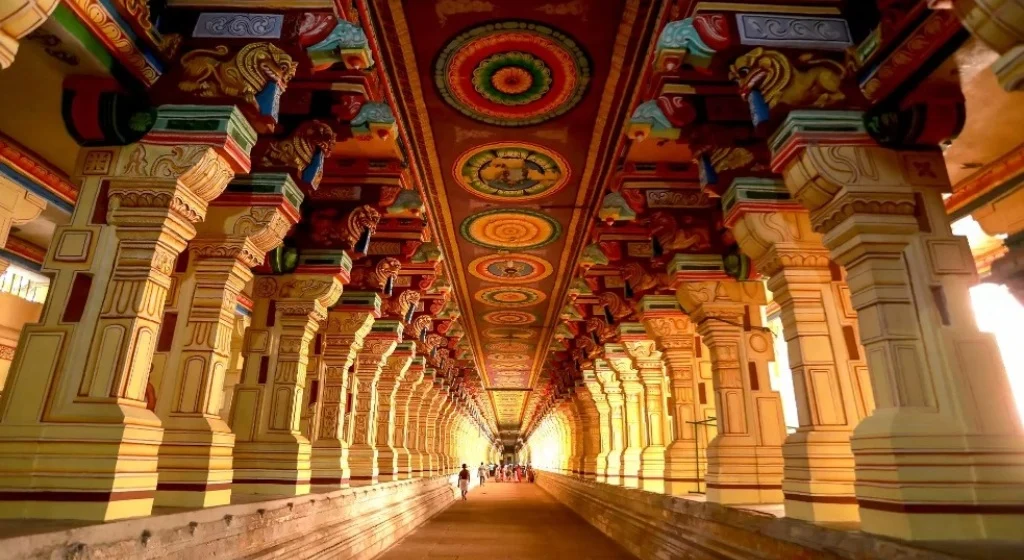
These corridors serve more than visual grandeur. They were designed to guide processions, manage pilgrim flow, and sustain acoustics for chanting and aartis. The play of light and shadow as you walk along these stone passageways is deeply meditative—a silent guide to inner sanctity.
Sanctum & Shrines
The main sanctum (garbhagriha) houses the Ramalingam, the sacred Shiva Linga made of sand by Lord Rama and Devi Sita.
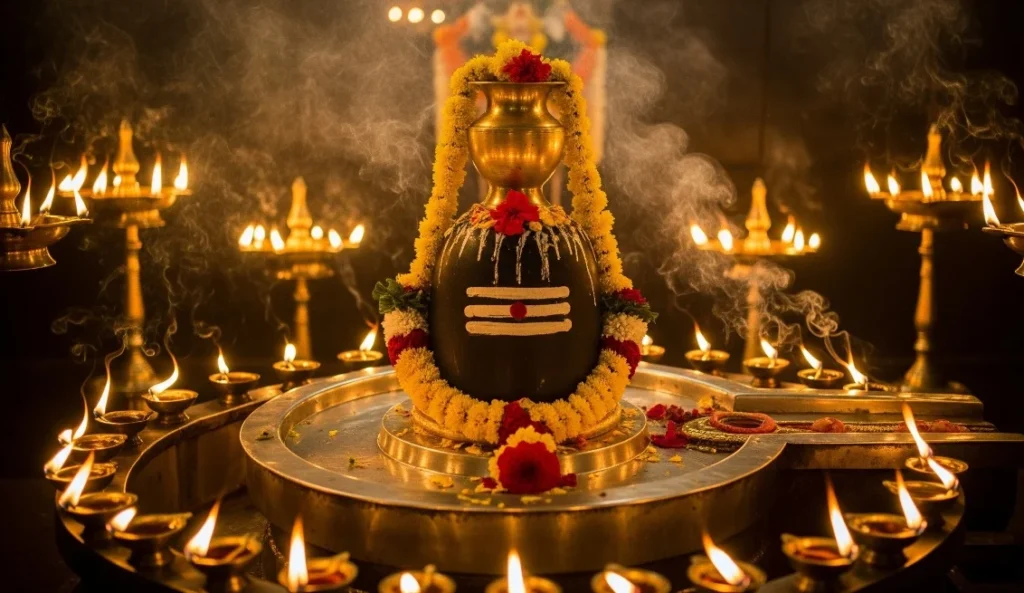
Nearby is the Viswalingam, the stone Shiva Linga brought by Hanuman from Kailash—worshipped before Ramalingam, as per Rama’s command.
Several sub-shrines dedicated to Lord Vishnu, Goddess Parvati, Hanuman, and Ganesha complete the divine circuit.
The sanctum’s vimana (tower) is relatively modest in height, preserving the humble intent of penance and forgiveness with which Rama worshipped Shiva. This understated elevation makes the horizontal expanse of the temple even more dramatic.
Theerthams: Sacred Water Tanks

The temple also contains 22 sacred wells (theerthams), each said to have a different taste and healing property. Archaeologically, these are feats of hydraulic planning in an area prone to salinity and erosion. Their stone-lining, depth variation, and subterranean connectivity reflect the temple builders’ mastery over geology and water engineering.
Building Materials and Techniques
Constructed primarily from granite and sandstone, the temple’s stone blocks were likely sourced from inland quarries and transported via the Pamban Bridge (post-construction) or coastal barges in earlier times. Traditional lime mortar was used for bonding, with natural coloring agents preserving the mural and stucco artworks.
As I walked barefoot on the sun-warmed stone floors, under soaring ceilings supported by endless pillars, I was overwhelmed by the silence they held—the echo of centuries of chants, footsteps, and whispered prayers. It wasn’t just architecture I was witnessing—it was living devotion carved into eternity.
Arrive early morning (5–7 AM) for a peaceful darshan and minimal crowds.
Rameswaram’s unique status as both a Char Dham (one of four sacred Hindu pilgrimages) and a Jyotirlinga site makes it spiritually unparalleled.
Geographical Location of Rameswaram
Rameswaram, home to the renowned Ramanathaswamy Temple, is a tranquil island town located in the Ramanathapuram district of Tamil Nadu, India. Geographically, it rests on Pamban Island, separated from mainland India by the Palk Strait and linked by the historic Pamban Bridge, one of the longest sea bridges in the country.
The town lies at 9.2876° N latitude and 79.3129° E longitude, sitting right on the Gulf of Mannar, close to the Sethusamudram—a shallow stretch of sea between India and Sri Lanka. Just about 30 km from Talaimannar in Sri Lanka, Rameswaram stands as a symbolic and spiritual link between the two ancient lands, echoing the epic journey of Lord Rama across the sea to Lanka.
How to Reach
Reaching Rameswaram, the southernmost Jyotirlinga and one of the Char Dham pilgrimage sites, is a soulful journey in itself. Though rail and road networks connect the temple town well, it still preserves a sense of isolation and sanctity, as if it’s guarding its secrets from the hurried world.
By Air
The nearest airport is Madurai International Airport (IXM), about 170 km from Rameswaram. Major cities like Chennai, Bengaluru, Mumbai, and Delhi maintain strong connections to Madurai by rail, road, and air. From the airport, you can hire a taxi or board a bus to Rameswaram. The drive takes around 3.5 to 4 hours, passing through scenic roads and over the iconic Pamban Bridge.
By Train
Trains from key cities in Tamil Nadu and a few long-distance routes from North and East India directly connect to Rameswaram Railway Station (RMM). Major trains include:
- Rameswaram Express (from Chennai)
- Sethu Express (from Chennai Egmore)
- Rameswaram–Okha Express (via Madurai and Bengaluru)
By Road
Rameswaram is accessible by road via the NH-87 and NH-49. Government and private buses operate regularly from:
- Madurai (170 km)
- Tiruchirappalli (230 km)
- Kanyakumari (309 km)
- Chennai (560 km)
Self-driving is also an option, especially for those seeking a road trip that blends history, sea views, and temple stops.
My Journey from Kolkata
Step 1: Kolkata to Chennai
I boarded the Coromandel Express (Train Number 12841) from Howrah. As the train rolled past the farmlands of West Bengal and entered the heart of Odisha, I could feel the noise of daily life slowly quiet down. There’s something poetic about train journeys—the rhythm of the rails, the conversations with strangers, and the chai breaks at forgotten stations.
The journey lasted about 25 hours, but I never checked the clock. Instead, I looked out at rivers, farmlands in the distance, and rural landscapes that felt timeless. With a mix of light reading, soulful music, and the warmth of fellow passengers, I reached Chennai Central, a sprawling hub of energy. My limbs were tired, but my spirit was alive.
Step 2: Chennai to Rameswaram
After a short breather in the city, I made my way to Chennai Egmore Station and boarded the Rameswaram Express (Train No. 16751). As the train chugged through Tamil Nadu, I passed by towns soaked in sacred history—Villupuram, Trichy and Madurai.
Watching the train cross over the legendary Pamban Bridge around 7 am was simply surreal. The Arabian Sea glimmered under the first light of day.
After around 13 hours, I reached Rameswaram, my mind already filled with anticipation and reverence.
Where to Stay
Staying close to Agni Theertham offers more than convenience—it gifts you the chance to begin your spiritual day with a walk along the sacred seashore. The soothing sound of waves, temple bells in the background, and devotees taking early morning dips create an atmosphere that feels truly divine.
My Stay Experience
During my visit, I chose to stay at Hotel Tamil Nadu – TTDC, which is barely a 5-minute walk from Agni Theertham. The location couldn’t have been more perfect. Every morning, I walked barefoot to the sea before sunrise. The serenity of the waves and the sight of pilgrims immersing themselves in the sacred waters created a scene I’ll never forget.
The hotel itself was clean, simple, and perfectly suited for spiritual travelers. I opted for an AC room, which was modest but well-maintained. The in-house restaurant served decent South Indian vegetarian meals, which felt just right after a long temple visit. The staff was polite and even helped arrange a local auto for my early morning darshan at Ramanathaswamy Temple.
Other Recommended Stays Nearby
1. Hotel Brindavan Residency
- Distance: ~300 meters from Agni Theertham
- Why Stay: Affordable, family-friendly, and good service
2. Jiwan Residency – Rameswaram
- Distance: ~500 meters, beach-facing
- Why Stay: Sea view rooms, ideal for those seeking modern comfort with a spiritual vibe
Nearby Places That Enrich the Journey
1. Dhanushkodi: India’s Ghost Town
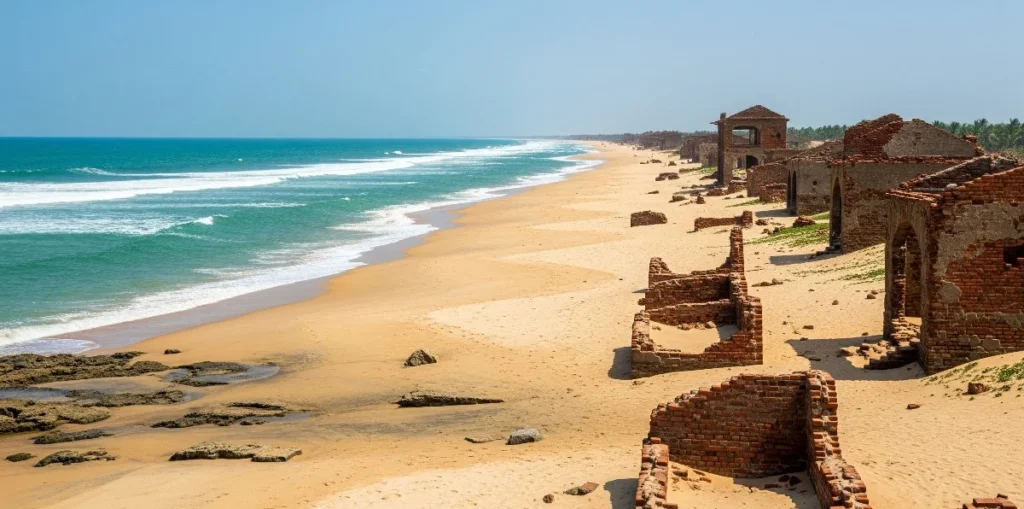
Located at the eastern tip of the island, Dhanushkodi was once a bustling town until it was destroyed in the 1964 cyclone. What remains is an ethereal landscape of ruins, sandbars, and silence.
According to legend, this is where Lord Rama’s vanara (monkey) army built the Ram Setu (Adam’s Bridge) to Lanka.
Did You Know? Satellite images show a chain of submerged limestone shoals between India and Sri Lanka that some scholars believe aligns with the mythical Ram Setu.
2. Agnitheertham: The Sacred Shore of Purification
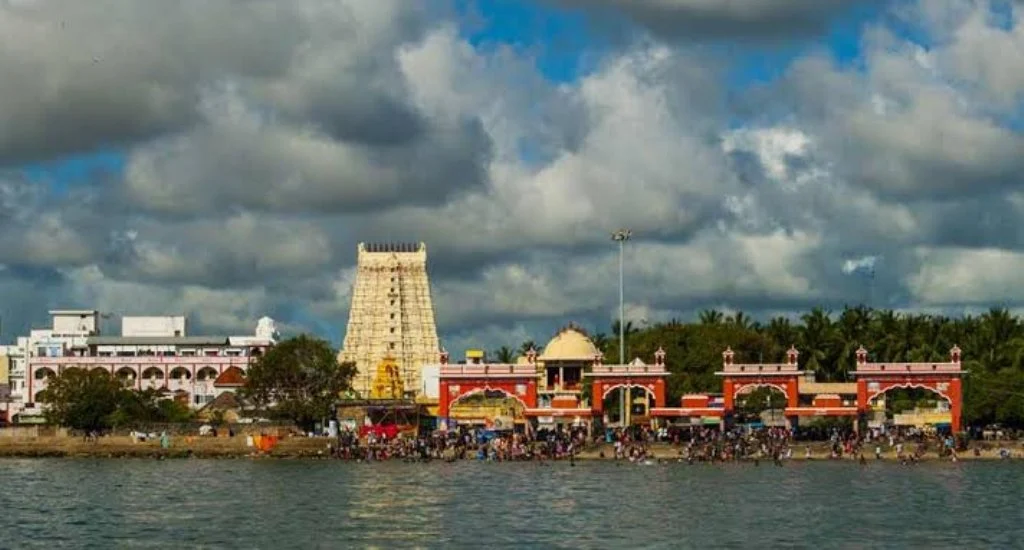
Just outside the Ramanathaswamy Temple, this sacred bathing ghat is where devotees take a dip before entering the temple. The waters here are calm and carry immense ritual significance. This stretch of the Bay of Bengal isn’t just a coastline—it’s a living shrine where earth meets water, and sins dissolve into surrender.
According to legend, Agni Dev, the fire god, took a holy dip here to cleanse himself of the sin of consuming the impurity of Sita during her Agni Pariksha. Hence, the name Agnitheertham, or the “holy water of fire,” reflects this divine redemption.
Early morning is considered the most auspicious time for a dip, especially on Amavasya and festival days.
3. Pamban Bridge
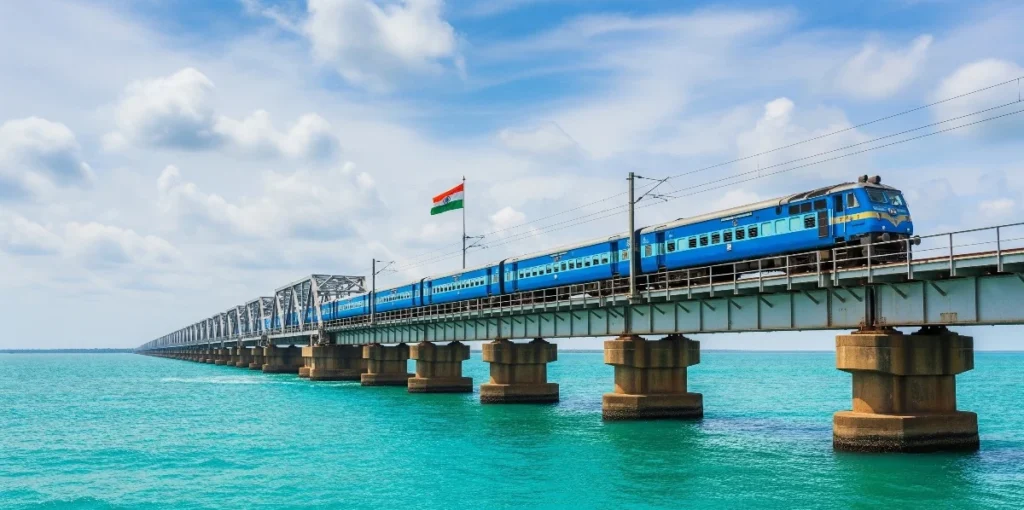
Before one even steps into the spiritual aura of Rameswaram, the journey itself becomes a divine experience—thanks to the magnificent Pamban Bridge. Stretching gracefully over the cerulean waters of the Palk Strait, this bridge connects the mainland town of Mandapam to the island of Rameswaram, serving as a symbolic and physical link between devotion and destination.
Commissioned in 1914, the Pamban Bridge was India’s first sea bridge and remained the longest until the Bandra-Worli Sea Link in Mumbai. Spanning 2.3 kilometers, it was built as a cantilever railway bridge, and what makes it truly fascinating is the double-leaf bascule section in the middle.
This section lifts up like a drawbridge to allow ships and barges to pass through—an architectural solution that remains functional even today.
In 1988, a parallel road bridge was added, offering breathtaking panoramic views to travelers en route to Rameswaram by car or bus.
Tip: Take a train journey across Pamban Bridge for breathtaking views.
4. Kothandaramaswamy Temple

This temple is believed to mark the spot where Vibhishana, the younger brother of Ravana, surrendered to Lord Rama. It was here that Rama accepted Vibhishana into his fold, recognizing his righteousness and loyalty to dharma. Vibhishana guided Rama’s army across the sea to Lanka and eventually became the king of Lanka after Ravana’s defeat.
Inside the sanctum, you’ll find rare idols of: Lord Rama, Devi Sita, Lakshmana, Hanuman and Vibhishana.
Travel Tip: If you’re driving to Dhanushkodi, stop by Kothandaramaswamy Temple early in the morning or during sunset. The breeze is gentle, and the sea is calm. You’ll feel the timelessness of Rama’s journey.
A Personal Glimpse of Rameswaram: Sunrise at the Edge of India
During my visit to Rameswaram, I chose to begin my day at Dhanushkodi. At 5:45 AM, the sky turned from ink to gold. I sat on a broken pillar near the shore, surrounded by silence and salt.
As the first sunbeam touched the ocean, I understood why sages chose isolation to find clarity. The place felt untouched by time, soaked in divinity. Rameswaram wasn’t just a destination. It was a pause, a prayer.
Best Time to Visit
- October to April: Pleasant weather and ideal for temple visits and exploration.
- Avoid May-June: High temperatures and humidity.
Eco-Spiritualism & Conservation
Rameswaram isn’t just a spiritual beacon but also an ecological hotspot. The surrounding waters are part of the Gulf of Mannar Biosphere Reserve, home to rare coral reefs, seagrass beds, and endangered marine life.
Tourists and pilgrims are increasingly encouraged to adopt eco-conscious travel practices, including avoiding plastic, respecting marine life, and supporting local conservation efforts.
Cultural and Festive Vibes
Rameswaram comes alive during festivals like:
- Maha Shivratri: Celebrated with elaborate rituals at Ramanathaswamy Temple.
- Ram Navami: Reenactments of episodes from the Ramayana.
- Float Festival (Theppotsavam): Deity processions on the temple tank.
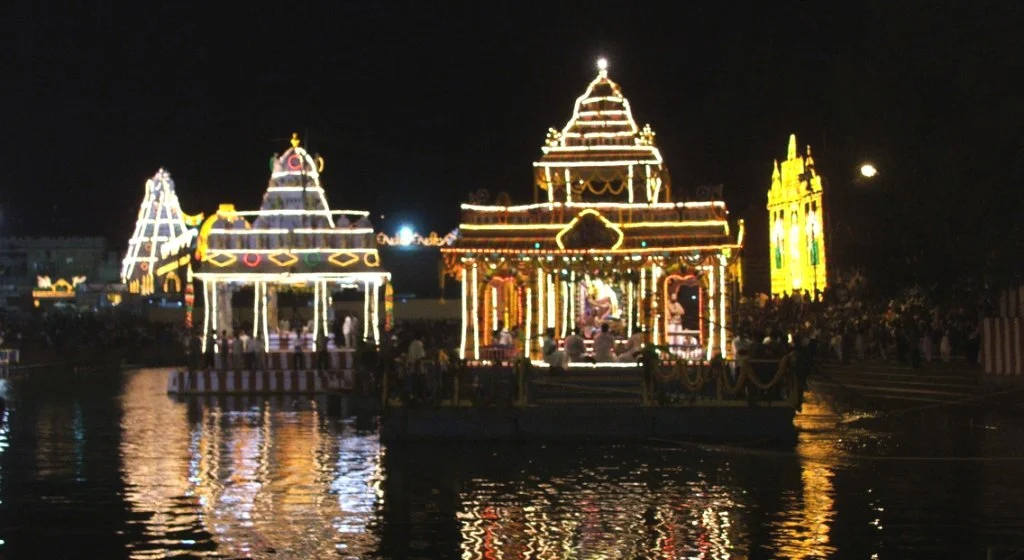
Local music, folk dances, and devotional chants create a mesmerizing atmosphere during these events.
Final Thoughts: Rameswaram is a Journey Within
Rameswaram is not just about temples and legends. It is about transformational travel. It urges you to leave your digital world behind, walk barefoot on sacred sands, and listen to ancient whispers carried by the wind.
Whether you’re a pilgrim, historian, nature lover, or curious traveler, Rameswaram is a doorway to inner clarity and timeless tales. It reminds us that faith can be both a heritage and a horizon.
May your journey to Rameswaram be filled with clarity, peace, and purpose.
External References to Deepen Your Exploration
Tamil Nadu Tourism Official Site
Incredible India – Rameshwaram
FAQs:
Yes, Ramanathaswamy Temple in Rameshwaram is indeed one of the twelve Jyotirlinga shrines dedicated to Lord Shiva.
By Air: Nearest airport is Madurai (174 km).
Train: Rameswaram Railway Station is 1.5 km from the temple.
By Road: Well-connected by bus and taxi from major Tamil Nadu cities.
It is renowned for its 22 holy wells (Theerthams), the world’s longest temple corridor, and its significance in the Ramayana, where Lord Rama is believed to have worshipped Lord Shiva.
It is open from 5:00 AM to 1:00 PM in the morning and reopens from 3:00 PM to 9:00 PM in the evening.
The VIP Darshan for the main deity costs ₹200, while special darshan for Ambal Sannathi (the goddess) is ₹50. There is also a ₹100 ticket for Swamy Sannathi Special Entrance Darshan.
One has to take a ticket of Rs.25 to get bath at these wells and there are people around these well who will keep pouring water on us.
Mani Darshan is held early morning every day 5.00AM to 6.00AM. People have to take tickets (₹50 per person) for “Mani” Dharshan. This is a precious crystal in the form of the “Holy Shivling”.
There are two lingams inside the sanctum – one built by Rama from sand, residing as the main deity, called the Ramalingam, and other one brought by Hanuman from Kailash, called the Vishvalingam.
The primary form of prasad at the Rameswaram Temple is Annadanam, a free, full-fledged South Indian vegetarian meal served on a banana leaf, available from 8 am to 8 pm with a token.



Pingback: Dwarka: Where Myth Meets the Arabian Sea - Temples of India